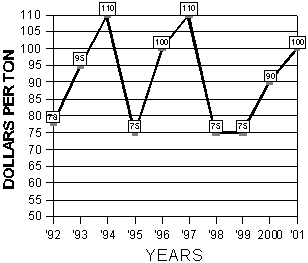Alfalfa Report
Yuma County, Arizona
October 22, 2001
Yuma County Office
2200 W. 28th Street, Ste. 102
Yuma, AZ 85364
(928) 726-3904
(928) 726-8472 FAX
Production Update:
PDF version, 37KB
Inoculation: Alfalfa seed normally does not need to be inoculated with Rhizobium bacteria unless planted on ground newly broken out of desert and not farmed before.
Insect Management: Sowbugs feed on alfalfa seedlings in new stands and reseeded fields. Sowbugs are crustaceans not insects. Alfalfa seed fields that have been dry for 6 to 8 weeks usually have more of a problem, especially if the field has received 1 or more inches of rain prior to renovation. Sowbugs will eat seedling alfalfa to the ground line. Feeding on leaves of older plants rarely cause economic damage. Monitor sowbug activity in alfalfa fields at night, after 9 p.m. Feeding damage commonly spreads out from field borders. Sowbugs may be found along field borders in the daytime hiding under litter. Carbaryl (SevinŽ) 5% bait may be applied broadcast at 30 lb/acre when sowbug densities are high enough to cause sever loss of seedling alfalfa stands.
Weed Control: Balan can be an effective preplant incorporated
herbicide in alfalfa. Injury is not uncommon, however, and weed control
can be poor where soils crack and weeds emerge from the cracks.
| Market Summary |
High
|
Low
|
Average
|
Off grade
|
| Past 2 Weeks (Oct. 9, 2001 to Oct. 21, 2001) |
105
|
90
|
100
|
80-90
|
| Last Year (Oct. 9, 2000 to Oct. 22, 2000) |
95
|
85
|
90
|
70-80
|
10 Year Summary (October 9, to October 21, 1992-2001):

Issued in furtherance of Cooperative Extension work, acts of May 8 and June 30, 1914, in cooperation with the U.S. Department of Agriculture, James A. Christenson, Director Cooperative Extension, College of Agriculture and Life Sciences, The University of Arizona.
The University of Arizona is an equal opportunity, affirmative action institution. The University does not discriminate on the basis of race, color, religion, sex, national origin, age, disability, veteran status, or sexual orientation in its programs and activities.
Any products, services, or organizations that are
mentioned, shown, or indirectly implied in this web document do not imply
endorsement by The University of Arizona.
Information provided by:
Barry Tickes, btickes@ag.arizona.edu Extension Agent, Yuma County
Michael Ottman, mottman@ag.arizona.edu Agronomy Specialist
College of Agriculture, The University of Arizona.
Eric Natwick, etnatwick@ucdavis.edu UCCE Imperial County - Farm Advisor
University of California, Davis, CA.
Material written October 22, 2001.
Forages: Crop Mgmt | Soil Mgmt | Irrigation | Alfalfa Reports | Insects | Diseases | Weeds | Pesticides
Home | Other Crops | Forages
For more Arizona Production Ag Information:
Home | Cotton | Veggies| Forages | Grains | Citrus | Crop x Crop | Insects | Diseases| Weeds | Pesticides | News | Weather | Research | Photos | Contacts | General Info. | Site Map
Copyright © 2001 University of Arizona,
College of Agriculture and Life Sciences
Webmaster: Al Fournier (fournier@ag.arizona.edu)